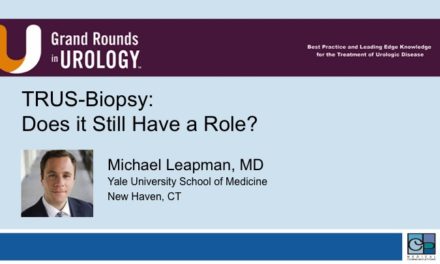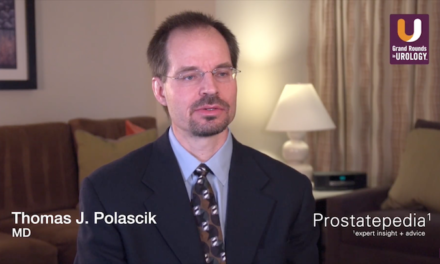Dr. M. Scott Lucia spoke at the 24th International Prostate Cancer Update on Thursday, February 20, 2014 on “CTC/DTC for Prognostic Value for Prostate Cancer” In his presentation, Dr. Lucia discusses how CTCs and DTCs can be used as prognostic indicators for prostate cancer.
Presentation:
Keywords: circulating tumor cells (CTC), disseminated tumor cells (DTC), phenotype, epithelial mesenchymal transformation, therapy
How to cite: Lucia, M. Scott. “CTC/DTC for Prognostic Value for Prostate Cancer.” January 9, 2015. Accessed Jan 2025. https://dev.grandroundsinurology.com/prostate-cancer-m-scott-lucia-ctc-dtc-prognostic-value/.
Transcript
CTC/DTC for Prognostic Value for Prostate Cancer –
I am going to be fairly brief and talk about CTC’s and DTC’s for prognosis value and prostate cancer.
So when we talk about this, we really need to go back to the origin of metastasis when we talk about CTC’s and DTC’s. What I’ve shown here on this picture is a tumor growing in the prostate. And we see different colors here because it really goes back to what we’ve talked about with biomarkers, the fact that there are different heterogeneity within a tumor and different clones do develop out of that prostate cancer. And then there is a change. Some of these clones go on to have the propensity to invade into a vessel. And once it goes into a vessel it can disseminate and eventually get to a distant organ site.
This process is really coupled with a process called EMT, epithelial mesenchymal transformation, where these cells kind of shown here as they elongate, did a more mesenchymal phenotype which allows them to be more mobile, invade more, and enter the bloodstream. Once they get to a distant site, this process sort of reverses and you get a mesenchymal epithelial transformation to go back to a more epithelial type of phenotype in the distant organ. When we talk about CTC’s we are talking about these, circulating tumor cells, within the vessel itself.
DTC’s are disseminated tumor cells and really refer to these cells here after they’ve arrived at a distant organ, say the bone marrow. Now what is important here is that this process looks to be one directional and that we actually have cells leaving the primary tumor here and going to the distant site. But once they’ve reached the distant site you can actually have tumor cells from the disseminated tumor cells back into the circulation. And so this is a very plastic process that occurs here. Now there is a key element here and it’s really reflected in this right here. And that is the fact that when in the bloodstream many of the cells that are tumor cells still have a mesenchymal phenotype, or at least a partial mesenchymal phenotype.
And that can be problematic when attempting to isolate tumor cells from the blood. So it seems more likely, or easier in a way, to actually get disseminated tumor cells but that is not true. It’s much more difficult, much more of an invasive process, and much more error involved in actually getting a bone marrow aspirate and identifying DTC’s than CTC’s. So in many ways the circulating tumor cells are an advantage or are a good group to look at. Now the problem with CTC’s is that they are rare. You don’t get a lot of them in an blood sample, and so they have to be enriched. And there is a variety of ways that have been used to do that.
The most common way is using immunoaffinity. You have antibodies against an epithelial epitope that you can then put on beads, that you can pull out magnetically, or reverse it and you can pull out the leukocytes in that process. And, again, once you’ve got that epithelial mesenchymal transformation there is the possibility that these epitopes are lost. So other things have been used like physical properties and size, using size to sort out these tumor cells using dielectrophoresis, for instance, to sort out these cells, so there are a lot of different approaches that have been used.
Once you’ve isolated them the good thing about CTC’s is that you can do a lot of things with them. The most common thing that we do is to immunophenotype them to look and see what markers they are showing so that we can determine that they are truly derived from tumor cells or from the tumor, for instance. You can even do ISH analyses on these, you can do mutational analyses, gene expression profiling. All of this can be done if you are able to isolate enough CTC’s and also depending on the enrichment type of method that you use.
So the strengths; blood is easy to obtain, a heck of a lot easier to obtain than a biopsy. And it can be serially followed. You can perform molecular and genetic analyses from tumor derived cells provided you can get enough cells. And it avoids the sampling problems associated with primary tumor heterogeneity and this is key. As we mentioned earlier, sampling can be a problem when looking at tissue based biomarkers. This may be better and it can be automated. The limitations, CTC’s are rare and therefore they must be enriched. And the enrichment process may be selective. You may not be pulling out all of the CTC’s that are present there depending on what kind of technique that you use. There is always contamination by blood cells, of course, and high cost.
But there is some clinical utility involved here, too. Baseline prognostic markers for metastatic castration-resistant prostate cancer is the first indication for CTC’s that were clinically approved by the FDA. And also it can be used to monitor the treatment of efficacy in that setting as well. But it has the potential of being the surrogate endpoint for clinical trials and being a potential predictive biomarker in that we can look at it to actually interrogate cells, for instance their response to androgen withdrawal therapy, or chemotherapy.
The only methodology that is used right now that is clinically approved by the FDA is the cell search assay put out by Veridex. It’s approved for use not only in prostate, but also for colorectal and breast. It’s a simple blood test and it does employ immunomagnetic separation. It uses anti-epithelial adhesion molecules, labeled to ferro iron nanoparticles which can then be pulled out with a magnet. So this kind of really shows that here as you are pulling out this anti-EpCAM molecule with a bead, and then you can go in and immunophenotype it with a cytokeratin to show that it is truly an epithelial cell. And this is kind of what they look like. The green is the cytokeratin; and the pink here is just DAPI, showing that it has a nucleus.
The seminal paper on this came out in 2008 and looked at, for prostate cancer anyway, and looked at a dichotomous cut point for CTC’s within a blood specimen which was 7.5 mL of blood, and showed that the median survival for patients with CTC’s of five or more in 7.5 mL of blood was significantly lower than those that had less than that in 5 mL of blood. And it showed also that you can use this to monitor therapy. Four different graphs here, the green shows that the patient at baseline had a favorable number of CTC’s, less than five and how they’ve done in terms of survival, overall survival here.
But the blue line actually shows someone who had a poor, unfavorable, more than five, five or more, CTC’s in their baseline analysis, but that that changed during the course of the therapy and so you can see the survival curves are much better than those that always had unfavorable CTC’s or converted from a favorable, the orange line, a favorable count to an unfavorable count when dichotomized at the 5 cc cut point. Now others have said the dichotomized is powerful, but in reality it could be more of a continuous variable. And from Howard Scher’s group they looked at it as a continuous variable that still shows really a risk of dying of the disease as a function of CTC’s in the blood. And in their analysis they looked at the fold change as being highly predictive of whether or not you would disease of prostate cancer or not. So if the fold change occurred here, you can see that the hazard ratio improved, or got worse depending on which direction the full change went.
Now that is in hormone refractory, the prostate cancer, its indication by the FDA. It’s been looked at in hormone sensitive prostate cancer. This group looked and showed that in the hormone sensitive region here, there is a different cut point, but again dichotomizing for CTC’s at a cut point of 3 showed that those with a CTC of less than 3 in 7.5 mL of blood, that their median survival, the survival out of five years, was around 30% before going to castrate resistant prostate cancer versus those that had greater than 3 CTC’s. And you can see how they performed here.
When I think the most promising area that we are going to see in the next five years in this area is being able to use CTC’s as a predictive biomarker and to really understand how they can be used to guide therapeutic decisions. This is an interesting study that came out last year and used a lot more blood than the 7.5 mL, so that is one caveat here. But they were able to immunosort, they used a microfluoretics platform to do this, and then they immunophenotyped the cells that they’ve got.
And it’s kind of sorted out here in this diagram to either having an AR on signal meaning that it showed a good high PSA signal when immunofluorescent antibodies of PSA were used or an AR off using PSMA and the negative, not staining for PSA. And then they were mixed, those that showed both PSA and PSMA pictured here. And they said with castrate sensitive prostate cancer, the majority of the CTC’s that were found had the AR on phenotype, whereas if you looked at castrate resistant disease, many of them had a high percentage of either the AR off or the AR mixed phenotype.
And, in fact, looking at it, they then looked at a group of patients treated with abiraterone acetate. And here is the Kaplan Meier curve here and it really shows that with those that had 10% or less than 10% of mixed phenotype that they did really quite well and responded to abiraterone acetate. And here is the survival curve for those that had a higher percentage of that mixed phenotype there. So this type of approach may in the future really be able to guide therapeutic decisions.
Before I end this I want to say one note about DTC’s. Disseminated tumor cells really are the target we’d like to understand more about and really understand prognostically and also for targeted therapy on what we are dealing with here. But, again, they can be hard to find. This is an interesting study looking at patients from the SBCG7 trial who were treated with neoadjuvant ADT plus RT with or without adjuvant hormone therapy. And they got bone marrow aspirates on all of these patients. Only 14% of them did they find tumor cells, but again these are patients who didn’t have evidence of metastatic disease clinically and yet we were pulling about 14% of them that did have DTC’s in their bone marrow.
And this is what happened if you had those. Just having one or more DTC pulled out here reduced your survival in that trial significantly. So this may be an approach that is used in the future, but CTC’s are far easier and safer to obtain than DTC’s at this point in time. The methods for quantifying CTC’s are evolving and I think we are going to see an improvement in some of the techniques going forward and what is being used to actually not just elucidate CTC’s, but actually characterize them. CellSearch Assay is currently FDA approved. Higher CTC’s at baseline are associated with a decrease in survival and the CTC’s may be used to monitor therapy over time.
And what we hope to have in the future is characterization of CTC’s as a potential predictive biomarker. I’ve just got one ARS question I’d like to throw up right now. The potential advantages of CTC testing over tumor tissue testing for biomarkers include which of the following: reduced impact of tumor heterogeneity, ability to monitor serially during therapy, an ability to obtain an abundance of tumor cells for ancillary biological testing, one or two above, the first two, or these last two, or all of the above? It is a good question. And the trick, and nobody fell for the trick right there, and that is to obtain an abundance of tumor cells. A biopsy is going to get you a whole heck of a lot more tumor cells than CTC’s will. We hope to be able to use them for biological tumor testing, but that is one of the limitations right now. So the answer really is number four here and most people got it right in terms of one and two above.
References
de Bono JS1, Scher HI, Montgomery RB, et al. Circulating tumor cells predict survival benefit from treatment in metastatic castration-resistant prostate cancer. Clin Cancer Res. 2008 Oct 1;14(19):6302-9. http://www.ncbi.nlm.nih.gov/pubmed/18829513
Goodman OB Jr, Symanowski JT, Loudyi A, et al. Circulating tumor cells as a predictive biomarker in patients with hormone-sensitive prostate cancer. Clin Genitourin Cancer. 2011 Sep;9(1):31-8. http://www.ncbi.nlm.nih.gov/pubmed/21705286
Harouaka R, Kang Z, Zheng SY, et al. Circulating tumor cells: advances in isolation and analysis, and challenges for clinical applications. Pharmacol Ther. 2014 Feb;141(2):209-21. http://www.ncbi.nlm.nih.gov/pubmed/24134902
Lilleby W, Stensvold A, Mills IG, et al. Disseminated tumor cells and their prognostic significance in nonmetastatic prostate cancer patients. Int J Cancer. 2013 Jul;133(1):149-55. http://www.ncbi.nlm.nih.gov/pubmed/23280694
Miyamoto DT, Lee RJ, Stott SL, et al. Androgen receptor signaling in circulating tumor cells as a marker of hormonally responsive prostate cancer. Cancer Discov. 2012 Nov;2(11):995-1003. http://www.ncbi.nlm.nih.gov/pubmed/23093251
Scher HI, Jia X, de Bono JS, et al. Circulating tumour cells as prognostic markers in progressive, castration-resistant prostate cancer: a reanalysis of IMMC38 trial data. Lancet Oncol. 2009 Mar;10(3):233-9. http://www.ncbi.nlm.nih.gov/pubmed/24134902
ABOUT THE AUTHOR
M. Scott Lucia, MD, is Professor and Vice Chair of the Department of Pathology and Director of Anatomic Pathology and of the Prostate Diagnostic Laboratory at the University of Colorado Anschutz Medical Campus (UCAMC) School of Medicine. He also serves as the Director of the Prostate Cancer Research Laboratories at UCAMC and of the UCAMC Biorepository Core Facility. Dr. Lucia received his MD from the University of Colorado School of Medicine in 1988. He completed his internship and residency in pathology at the University of Colorado in 1993. He was a research fellow in the Laboratory of Chemoprevention at the National Institutes of Health from 1993 to 1995, before returning to the University of Colorado in 1995.
Dr. Lucia served as the primary pathologist for the Prostate Cancer Prevention Trial (PCPT) and Vitamin E and Selenium Chemoprevention Trial (SELECT), sponsored by the Southwest Oncology Group; the Medical Therapy of Prostate Symptoms (MTOPS) trial, sponsored by the NIDDK; and the Reduction with Dutasteride of Clinical Progression Events in Expectant Management of Prostate Cancer (REDEEM), sponsored by GlaxoSmithKline. He directs the operation of several tissue and serum biorepositories for prostate and prostatic diseases, including those for the PCPT, MTOPS, SELECT, and the University of Colorado Cancer Center Prostate Biorepository. He has authored or co-authored over 180 peer-reviewed articles, reviews, editorials, and book chapters. His primary areas of interest include pathology of prostate cancer and hyperplasia, early detection and prevention of prostate cancer, prostate cancer biomarkers, and mechanisms of carcinogenesis.





